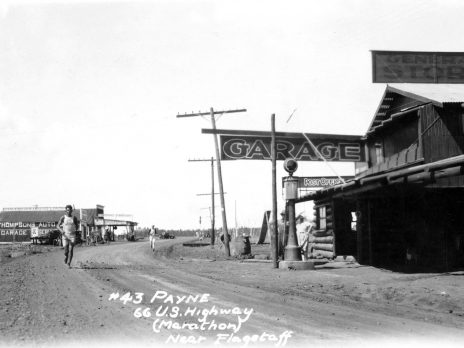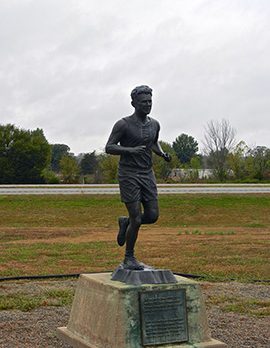It all begins with America’s First Annual Transcontinental Footrace organized by the country’s first sports agent, Charles Pyle in 1928 and dubbed the “Bunion Derby” by the press. The race began in Los Angeles, California and followed Route 66 through Arizona, New Mexico, Texas and Oklahoma, then crossing the Mississippi River and on to Indiana, Ohio, into Pennsylvania and down Route17 to New Jersey, finally reaching the finish line in New York City for a total of approximately 3,400 miles.
For a twenty year old, part-Cherokee Indian runner named Andy Payne, it was the chance to pay off the family farm back in Oklahoma and to make a name for himself. He turned to the chamber of commerce in his hometown of Claremore, Oklahoma for financial backing and despite skepticism was given a donation of $75. Andy’s father borrowed additional funds to pay for the entry fee along with money for shoes and a trainer.
On March 4, 1928, with representation from all over the world, 276 runners and walkers gathered at the starting line. Hopi runner and Arizona native, Nickolas Quomawahu was also hoping to finish. After the first day 77 runners had dropped out due to injuries and exhaustion. So many of those who bowed out suffered from callouses and blisters that the race got its nickname of “The Bunion Derby.” By the time they reached Flagstaff, Quomawahu was left with an ankle injury that ended the race for him. Only 102 racers left from Flagstaff with Andy Payne continuing despite a case of tonsillitis

Runners continued to drop out as they moved through New Mexico and into Texas. In his home state of Oklahoma, Andy was greeted to a hero’s welcome by residents and the state’s governor.
Through the remaining states, runners continued to drop out, some of them struck by vehicles or motorcycles. On the last day of the race only 55 runners remained. Andy crossed the finish line in first place on May 26, 1928, covering 3,422.3 miles in a little more than 573 hours and earning him the first place prize of $25,000. Following his win, he was married and settled down in his home state where he served as a clerk to the Supreme Court of Oklahoma and died in 1977. Every year Oklahoma City holds the Andy Payne Bunion Run, a marathon to honor their home state hero. A bronze statue of Andy stands along Route 66 in Foyil, Oklahoma, where our Own Sean Evans and his wife took this photograph.

In 1929, Pyle tried to recreate the race. This time runners would leave from the East Coast and Arrive in the West. The race was not financially successful , leaving the winner, John Salo with no prize money.
Books About the Great Bunion Derby
For more interesting facts about the characters that emerged from the Bunion Derby, check out any of the following titles:
C.C. Pyle’s Amazing Foot Race: The True Story of the 1928 Coast-to-Coast Run Across America by Geoff Williams,
The Great American Bunion Derby by Molly Levite Griffis
The Great American Foot Race: Ballyhoo for the Bunion Derby by Andrew Speno
The Bunion Derby: The 1928 Footrace Across America by Charles B Kastner
The Bunion Derby, Andy Payne and the Transcontinental Footrace by James Harold Thomas
The 1928 Bunion Derby: a Historical Tour and Driving Guide by Chicago to New York City
Hopi Runners: Crossing the Terrain Between Indian and American by Matthew Sakiestewa Gilbert